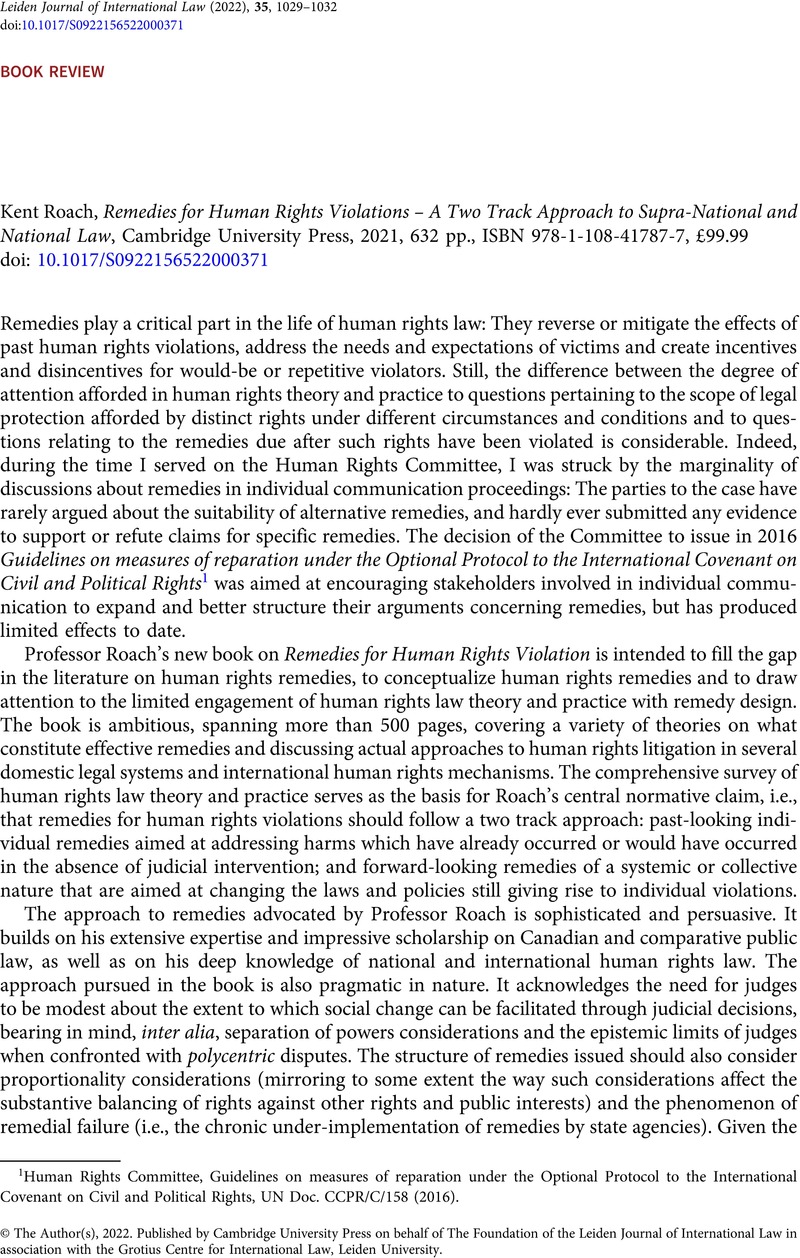No CrossRef data available.
Article contents
Kent Roach , Remedies for Human Rights Violations – A Two Track Approach to Supra-National and National Law, Cambridge University Press, 2021, 632 pp., ISBN 978-1-108-41787-7, £99.99
Review products
Published online by Cambridge University Press: 18 August 2022
Abstract

- Type
- Book Review
- Information
- Copyright
- © The Author(s), 2022. Published by Cambridge University Press on behalf of The Foundation of the Leiden Journal of International Law in association with the Grotius Centre for International Law, Leiden University
References
1 Human Rights Committee, Guidelines on measures of reparation under the Optional Protocol to the International Covenant on Civil and Political Rights, UN Doc. CCPR/C/158 (2016).
2 K. Roach, Remedies for Human Rights Violations – A Two Track Approach to Supra-National and National Law (2021), 524–5, 533.
3 Ibid., at 331–2.
4 Ibid., at 276–7.
5 Ibid., at 117–18.
6 Ibid., at 119–21. Roach mentions the UK prisoner voting saga as illustrative of a situation where individual remedies could have better supported a policy change than a general declarative remedy (p. 223).
7 For a discussion see, e.g., Ø. Stiansen, ‘Directing Compliance? Remedial Approachand Compliance with European Court of Human Rights Judgments’, (2021) 51 British Journal of Political Science 899, at 900–5; C. M. Bailliet, ‘Measuring Compliance with the Inter- American Court of Human Rights: The Ongoing Challenge of Judicial Independence in Latin America’, (2013) 31 Nordic Journal of Human Rights 477, at 478–80, 494–5; P. B. M. da Cruz, ‘Trackers and Trailblazers: Dynamic Interactions and Institutional Design in the Inter-American Court of Human Rights’, (2020) 11 Journal of International Dispute Settlement 69, at 84–9; K. Dzehtsiarou and V. P. Tzevelekos, ‘The Conscience of Europe that Landed in Strasbourg: A Circle of Life of the European Court of Human Rights’, (2020) 1 European Court of Human Rights Law Review 1, at 3.
8 Roach, supra note 2, at 97–9.
9 Ibid., at 389.
10 Ibid., at 376.
11 Ibid., at 81, 265.
12 Ibid., at 26.
13 Ibid., at 107.
14 Ibid., at 91–2.
15 Ibid., at 132.
16 Ibid., at 160–6.
17 Ibid., at 179.
18 Ibid., at 414.
19 Ibid., at 199, 202. Such remedies would be suitable when dealing with the rights of unprotected groups, such as members of the LGBT+ community, resulting in adding them to lists of protected groups or striking out language that excludes them from the scope of protection. Remedies of this nature do give rise, however, to considerable separation of powers concerns.
20 Ibid., at 242.
21 Ibid., at 256.
22 Ibid., at 240.
23 Ibid., at 267.
24 Ibid., at 273.
25 Ibid., at 432.
26 Ibid., at 482. Roach warns, however, against the adverse effects which may derive from gaps between bargaining powers of governments and indigenous powers and about the risk of settling for procedural obligations of consultations as a substitute for upholding the rights of indigenous peoples.




